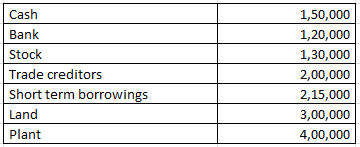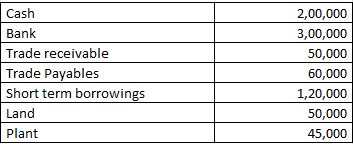Activity Ratio Analysis
Activity Ratio Analysis: Activity ratios are financial analysis tools used to measure a business’ ability to convert its assets into cash. These ratios are known as turnover ratios because they indicate the rapidity with which the resources available to the concern are being used to produce revenue from operations.
The different types of activity ratios are:
- Inventory Turnover Ratio
- Trade Receivables Turnover Ratio
- Trade Payables Turnover Ratio
- Working Capital Turnover Ratio
- Net Assets or Capital Employed Turnover Ratio
1. Inventory Turnover Ratio – Type of Activity Ratio
It indicates the relationship between the cost of revenue from operations during the year and average inventory during the year.

Here, Cost of Revenue from Opearions = Opening Inventory + Purchases + Carriage Inward + Wages + Other Direct Charges – Closing Inventory
2. Trade Payables Turnover Ratio – Type of Activity Ratio
It indicates the relationship between credit purchases and average trade payables during the year.

Trade Payables include Creditors and Bills Payables.
3. Trade Receivables Turnover Ratio – Type of Activity Ratio
It indicates the relationship between credit revenue from operations and average trade receivables during the year.

4. Working Capital Turnover Ratio – Type of Activity Ratio
This ratio is important in non-manufacturing concerns where current assets play a major role in generating sales. It indicates the efficient use of working capital.
5. Net Assets or Capital Employed Turnover Ratio
It signifies the relationship that exists between the sales of an enterprise and its net assets (capital employed). The higher the ratio the better it is, as it reflects the better performance of the business.
The formula for calculating the Net Assets or Capital Employed Turnover Ratio :
= Revenue from Operation/ Capital Employed
Activity Ratio Examples
Calculation of current assets turnover ratio – Activity Ratio Analysis – Question 1
From the following information calculate the Current assets turnover ratio:

Revenue from the operation for the year were RS. 2800000
Explanation : –

Current assets turnover ratio = 2800000/400000
Current assets turnover ratio = 7 Times
Working note 1 : Current assets = Cash + Bank + Stock
Current assets = 150000 + 120000 + 130000
Current assets = 400000
Calculation of inventories when Inventory Ratio is given – Activity Ratio Analysis – Question 2
Calculate the value of opening Inventory from the following information.
The cost of revenue from operations is 1200000 and the Inventory turnover ratio is 3 Times. and opening inventory is 40000 less than the closing inventory
Explanation: –

3 = 1200000/Average inventory
Average inventory = 400000
Workings:
Opening inventory = 400000 (-)40000/2
Opening inventory 380000
Closing inventory = 400000 (+)40000/2
Closing inventory = 420000
Activity Ratio Analysis – Activity Ratio Analysis – Question 3
Calculate the value of opening Inventory from the following information:
The cost of revenue from operations is 16000 and the Inventory turnover ratio is 1 Time. and opening inventory is 6 Times More than the closing inventory.
Explanation : –

1 = 16000/Average inventory
Average inventory = 16000
Workings:

32000 = Opening inventory + Closing inventory
Since the opening inventory is 6 Times More than the closing inventory, therefore, the ratio between opening inventory and closing inventory will be 7: 1
Opening inventory = 32000 x 7/8
Opening inventory = 28000
Closing inventory = 32000 x 1/8
Closing inventory = 4000
When inventory and current assets given – Activity Ratio Analysis – Question 4
From the following information compute the current ratio.

Explanation: –

Current Ratio = 900000/300000
Current Ratio = 3 :1
Workings:
Working Capital = Current assets (-) Current liabilities
600000 = 900000 (-) Current liabilities
Current liabilities = 300000
Fixed assets turnover ratio – Activity Ratio Analysis – Question 5
From the following information, calculate fixed assets turnover ratio:
Revenue from the operation for the year were RS. 2000000
Explanation : –

Fixed assets turnover ratio = 2000000/500000
Fixed assets turnover ratio = 4 Times
Total Fixed assets = Land + Building + Furniture
Total Fixed assets = 300000 + 50000 + 150000
Total Fixed assets = 500000
Inventory turnover ratio and the average age of inventory – Question 6
Calculate Inventory turnover ratio and the average age of inventory from the following information:

Explanation: –

Inventory turnover ratio = 1176000/30000
Inventory turnover ratio = 39.2 Times

The average age of inventory = 360/39.2
= 9.18 Days
Workings:
Cost of goods sold = Net Sales (-) gross profit
1200000 (-) 2% X 1200000
1200000 (-) 24000
1176000
Net sales = Cash sales + Credit Sales (-) Return Inwards
800000 + 400000 (-) 0
1200000

= 30000
Inventory turnover ratio when closing stock is given – Activity Ratio Analysis – Question 7
Calculate the Inventory turnover ratio from the following information:

Explanation: –

Inventory turnover ratio = 600000/240000
= 2.5 Times
Workings:
Cost of goods sold = Net Sales (-) gross profit
= 2000000 (-) 70% x 2000000
= 2000000 (-) 1400000
= 600000
Net sales = Cash sales + Credit Sales
500000 + 1500000
2000000

Average inventory = 240000
Cost of goods sold = Opening inventory + Purchases (-) Closing inventory
600000 = Opening inventory + 840000 (-) 360000
= Opening inventory + 480000
Opening inventory = 120000
Inventory turnover ratio when GP ratio based on cost – Activity Ratio Analysis – Question 8
Calculate Inventory turnover ratio from the following information: Gross profit ratio is 10 % Of cost and revenue from the operation is RS. 770000. Opening inventory was 9/11 of closing inventory and closing inventory was 10 % of revenue from the operation.
Explanation : –

Inventory turnover ratio = 700000/70000
Inventory turnover ratio = 10 Times
Working note: = Gross profit ratio is 10% Of cost
Therefore goods costing Rs. = 100 is sold for RS. 110
Cost of goods sold = 100
If revenue from operation is = 770000
Cost of goods sold = 700000 ( 770000 X 100/110 )

= 70000
Closing inventory = 10% x Revenue from operation
Closing inventory = 10% x 770000
Closing inventory = 77000
Opening inventory = 9/11 x Closing inventory
Opening inventory = 9/11 x 77000
Opening inventory = 63000
Inventory turnover ratio when GP ratio is negative – Activity Ratio Analysis – Question 9
Calculate the Inventory turnover ratio from the following information:

Explanation: –

Inventory turnover ratio = 525000/37500
Inventory turnover ratio = 14 Times
Workings:
Cost of goods sold = Revenue from operation (-) gross profit
= 500000 (-) -5% X 500000
= 500000 (-) -25000
= 525000

= 37500
Inventory turnover ratio when opening stock is given – Activity Ratio Analysis – Question 10
Calculate the Inventory turnover ratio from the following information:

Explanation: –

Inventory turnover ratio = 280000/80000
Inventory turn over ratio = 3.5 Times
Workings:
Cost of goods sold = Opening inventory + Purchases + Direct expenses – Closing inventory
280000 = 40000 + 300000 + 60000 – Closing inventory
Closing inventory = 120000

Average inventory = 80000
Total assets turnover ratio – Question 11
From the following information calculate the total assets turnover ratio.

Revenue from the operation for the year was RS. 4800000
Explanation: –

Total assets turnover ratio = 4800000/1600000
Total assets turnover ratio = 3 Times
Working note 1 : Total assets = Inventories + Cash + Sundry debtors + Land + Plant
Total assets = 125000 + 400000 + 175000 + 400000 + 500000
Total assets = 1600000
Working capital turnover ratio – Question 12
From the following information calculate the working capital turnover ratio:

Revenue from the operation for the year was RS. 1850000
Explanation : –

Working capital turnover ratio = 1850000/370000
Working capital turnover ratio = 5 Times
Working note 1: Working capital = Current assets (-) Current liabilities
Working capital = 550000 (-) 180000
Working capital = 370000
Working note 2 : Current assets = Cash + Bank + Trade receivable
Current assets = 200000 + 300000 + 50000
Current assets = 550000
Working note 3: Current liabilities = Trade Payables + Short term borrowings
Current liabilities = 60000 + 120000
Current liabilities = 180000
Determination of current assets when current ratio is given – Question 13
The current ratio of a business is 13: 11 and the Quick Ratio is 0.75.
If Working Capital is Rs. 200000 then calculate the value of current assets and inventory.
Explanation : –
Working Capital = Current Assets (-) Current Liabilities
or
Current Liabilities = Current Assets (-) Working Capital
= 1300000 (-) 200000
= 1100000

or
Liquid Assets = Current Liabilities x Quick Ratio
= 1100000 x 0.75
= 825000
Inventory = Current Assets (-) Liquid Assets
= 1300000 (-) 825000
= 475000
Working Note 1 :
Working Capital = Current Assets (-) Current Liabilities
Working Capital = 13 (-) 11
Working Capital = 2
When working capital = 2 then Current Assets = 13
When working capital = 200000 then Current Assets = 1300000
Trade payable turnover ratio – Activity Ratio Analysis – Question 14
Calculate the trade payable turnover ratio and average payment period From the following information. Credit purchases during 2016-2017 are 1000000. Balance of opening Creditors and Bills payable on 01.04.2016 is RS. 40000 and 15000 and the Balance of Closing Creditors and bills payable on 31.03.2017 is RS. 35000 and 10000
Explanation: –

Trade Payable Turnover Ratio = 1000000/50000
Trade Payable Turnover Ratio = 20 Times

Average Payment period = 360/20
Average Payment period = 18 Days
Workings:

Average trade Payables = 100000/2
Average trade Payables = 50000
Trade receivable turnover ratio – Activity Ratio Analysis – Question 15
Calculate the Trade receivable Turnover Ratio and average collection period from the following information: Total revenue from the operation is 100000 and cash revenue is 10 % of total revenue from the operation. The balance of opening receivable on 01.04.2016 is RS. 60000 and the Balance of Closing receivable on 31.03.2017 is 40000
Explanation: –

Trade receivable Turnover Ratio = 90000/50000
Trade receivable Turnover Ratio = 1.8 Times

Average Collection period = 360/1.8
Average Collection period = 200 Days
Workings:
Credit sales = 100000 x 0.9
= 90000

Average trade receivables 50000
Chapter 5 – Accounting Ratios
